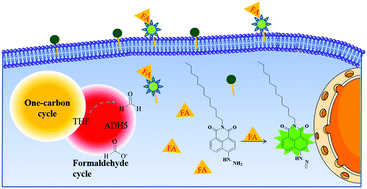A novel cell membrane-targeting fluorescent probe for imaging endogenous/exogenous formaldehyde in live cells and zebrafish†
Abstract
Formaldehyde (FA), an economically important chemical, has become a global pollutant and poses a threat to human health. As a kind of reactive carbonyl species, the abnormal production and degradation of FA in cells are related to many diseases. Therefore, it is of great significance to detect FA on the cell membrane and identify the internal and external sources of FA to analyse the causes of FA-induced physiological and pathological changes. In this work, a novel fluorescent probe Mem-FA was constructed by combining a dodecyl chain to target the cell membrane. Based on photoinduced electron transfer (PET), the probe relies on hydrazine as the receptor for FA recognition. Through this mechanism, the probe can detect FA sensitively, selectively and quantitatively. In addition, the probe Mem-FA can detect FA in vivo, especially the endogenous FA produced by tetrahydrofolate in a one-carbon cycle. More importantly, the probe Mem-FA can sensitively detect and distinguish the internal and external sources of FA on the cell membrane. Therefore, Mem-FA is capable of specifically tracing the fluctuations of FA-induced diseases.



 Please wait while we load your content...
Please wait while we load your content...